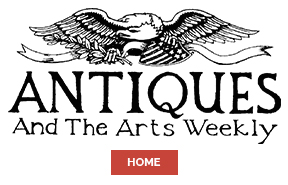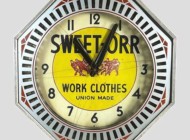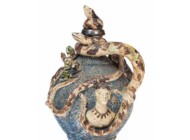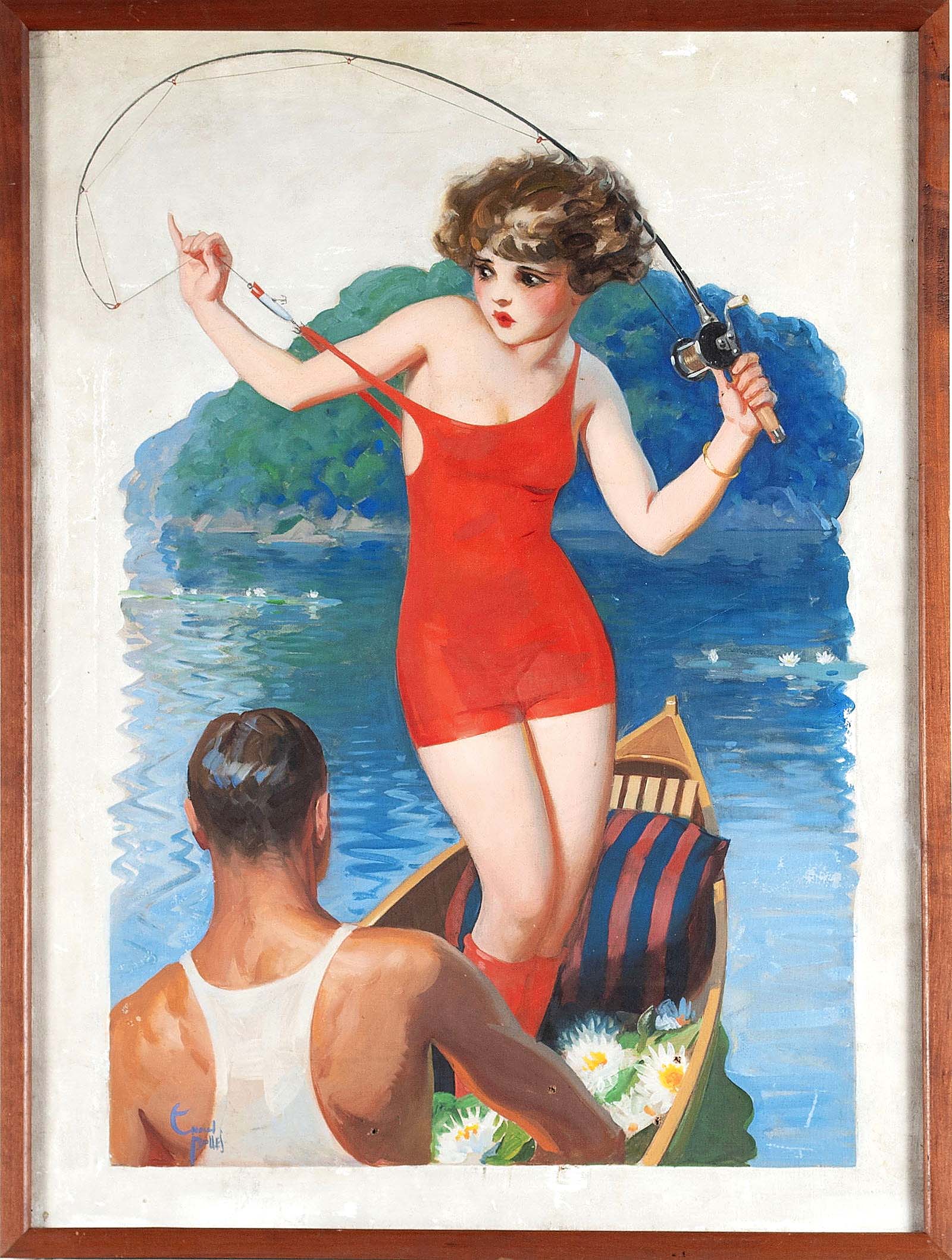
This cover illustration for the June 9, 1923, edition of Judge Magazine by Enoch Bolles (American, 1883-1976), oil on canvas, 31¼ by 23 inches framed, signed lower left, included notes for the cover in pencil on the back of the canvas. The painting went fishing for $28,750, the highest of the day ($4/8,000).
Review by Kiersten Busch
ST LOUIS — The lifetime collection of Dorothy G. Ridder (Alton, Ill.) and select pieces from the collection of Albert “Randy” Peckham and Garry Westher (Richmond, Mo.) were offered alongside additional lots of Eighteenth and Nineteenth Century American furniture, fine and folk art, decorative art and collectibles in Selkirk Auctioneers & Appraisers’ Fine Art + Interiors | Americana auction. The 233-lot sale was conducted on March 21.
The sale was led by Enoch Bolles’ oil on canvas cover illustration for the June 9, 1923, issue of Judge Magazine. The painting depicted a pin-up style woman in a red bathing suit standing in a rowboat with a male companion. The woman’s swimsuit was caught on a fishing hook, connected to a fishing rod she was wielding. Despite a $4/8,000 estimate, the cover ensnared a $28,750 finish.
Twenty-five additional paintings crossed the block during the sale, ranging in price from $63 for an oil on canvas winter landscape signed “J Weiler,” to the $2,125 earned by two Pennsylvania folk art watercolors, one depicting a horse and the other a potted tulip plant. Both framed, the two paintings dated to the Nineteenth or early Twentieth Century and hailed from the Ridder collection.
The American School was also well represented, with 13 paintings crossing the block. The group was led by a pair of watercolor portraits of a husband and wife from the mid Nineteenth Century, which wed for $813. Additional portraits followed, with a portrait of a seated boy ($625), a bust-length portrait of a young woman in black ($500), a portrait of Enos Wilder ($406) and a bust-length portrait of a gentleman ($250) all finding new homes.
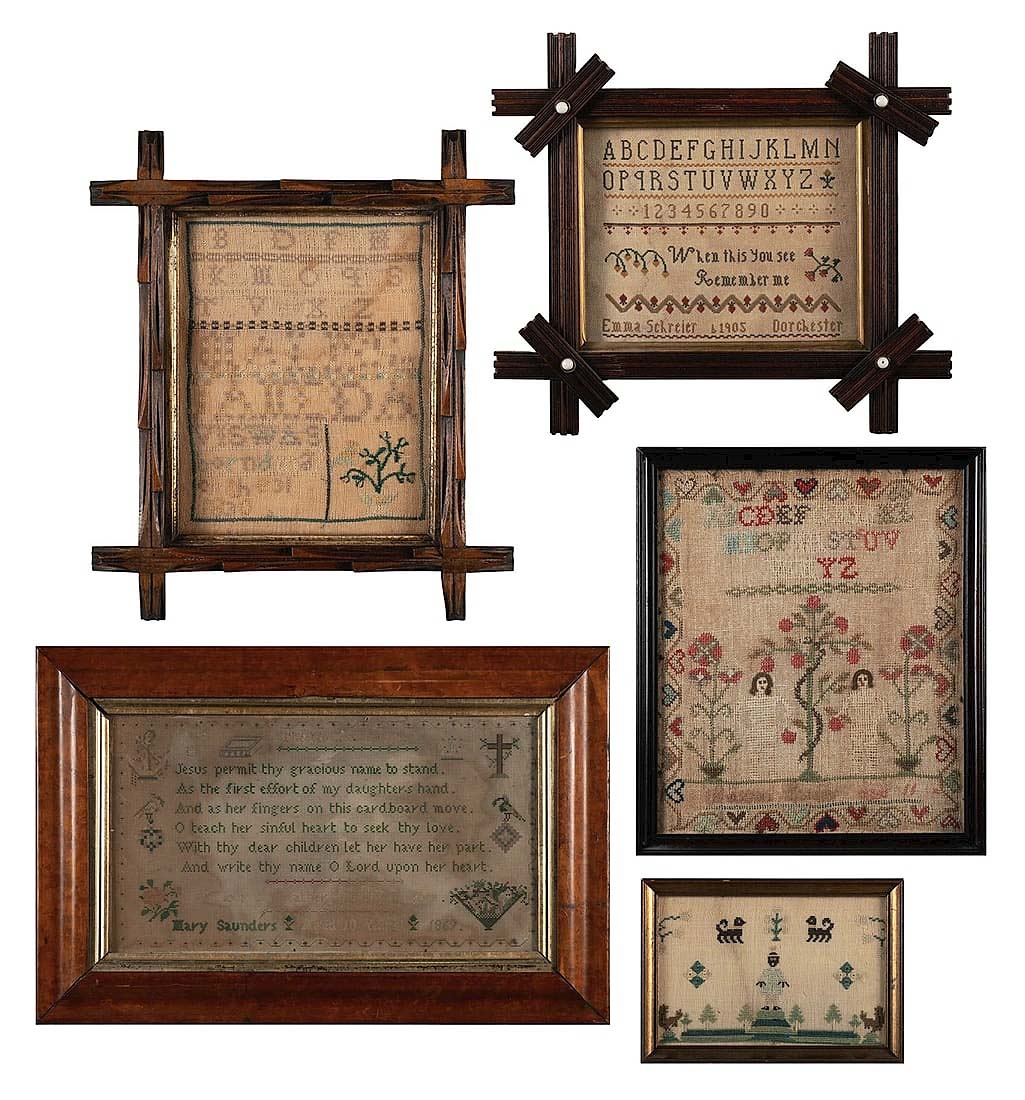
This lot of five framed needlework samplers contained four that were signed and dated; all originated from the Nineteenth or early Twentieth Century, and the group stitched closed at $750 ($100/200).
Two lots of needlework samplers crossed the block: a group of five for $750, and a group of four for $688. Those in the larger group were all made between the Nineteenth and early Twentieth Century, with four being signed and dated.
Of the 142 pieces of furniture sold, a Southern Sheraton cherry sugar chest from Tennessee or Kentucky had the highest price. Built circa 1825, the piece had a rectangular hinged top, a dovetailed case and bobbin-turned legs. A second cherry sugar chest, most likely from Tennessee, closed its drawers for $1,500.
Cherry chests were not the only cabinets that received attention from bidders. Thirty additional lots in the cabinets, armoires and cupboards category sold, with prices ranging from $88 to $1,875. The latter came from a miniature tabletop step back cupboard from the Nineteenth Century, which far surpassed its $300/600 estimate. The pine cupboard stood on bracket feet and was painted green. A cherry New England Chippendale highboy from the Eighteenth Century ($1,500) and a vinegar and sponge painted pine blanket chest from the Nineteenth Century ($1,250) also sold well above their estimates.
Four lots of furniture from the Peckman & Westher collection were featured in the sale, led by a Nineteenth Century Massachusetts manogany dressing table, attributed to Thomas Seymour (1771-1848), which was bid to $1,250. The rest of their collection also found new homes: a Regency style mahogany triple-pedestal dining table ($500), a Federal eight-leg sofa ($125) and two pairs of brass andirons, sold together ($75).

Rolling out for $2,625 was this Nineteenth Century northwest Persian Bakshaish rug, which measured 14 feet 8 inches by 10 feet 11 inches ($2/4,000).
Also in the furniture category were the six rugs offered. An approximately 15-foot-long Bakshaish room rug led the group at $2,625, the third highest price overall in the sale. Hailing from Northwest Persia and made in the Nineteenth Century, the rug contained an ivory primary border and red guard border, which centered a floral on navy pole medallion, placed inside of an ivory medallion with saw tooth lining. Another unique offering was an American hooked rug that dated to the late Nineteenth or early Twentieth Century. With a striped hourglass pattern, the rug measured 37¼ inches long and rolled out to $563, almost quadrupling the high end of its $100/150 estimate.
The rest of the rugs that will soon rest in new homes included: a Kazak area rug ($594), a West Persian Sennah area rug ($344), a Lilihan throw rug ($250) and a Turkish kilim hall rug ($75).
Turning away from furniture, a sterling silver Oneida Heirloom flatware dinner service for 12 in the Grandeur pattern led a group of five silver and vertu lots at $2,500. The 88-piece American set, which also included 15 pieces of holloware, was made in the Twentieth Century and contained interesting pieces such as pickle/olive forks, a sugar shell spoon and a tomato server. Another set of flatware, this one by Wallace and in the Grand Colonial pattern, contained 50 pieces and set the table for $1,125.
Additional silver to cross the block included a Frank Smith Silver Co., sterling silver pitcher and six A.G. Schultz and Co., goblets which filled up for $1,500; a collection of 10 Manchester silver goblets and nine Gorham silver cordials that served up a $1,375 finish and a late Nineteenth or early Twentieth Century silver repoussé lidded bowl stamped “Germany,” which was accompanied by 10 Webster Co., corn kernel splitters that earned $531.
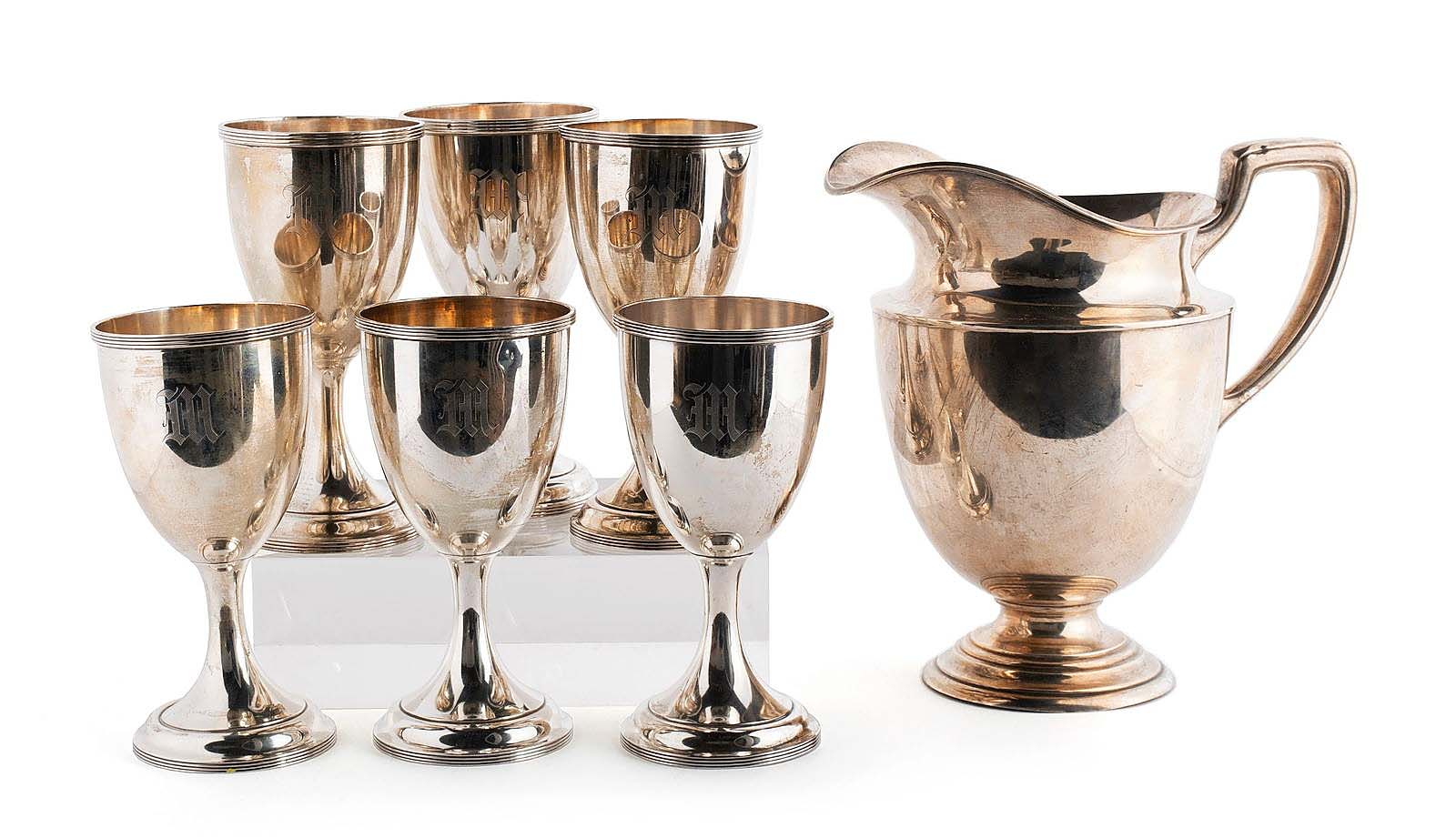
These six A.G. Schultz and Co., silver goblets and Frank Smith Silver Co., helmet form pitcher, all marked and monogrammed, hailed from the Twentieth Century and set the table for $1,500 ($1/1,500).
Stoneware was also in abundance for new collectors or experienced collectors looking to expand. Five separate lots crossed the block, ranging in price from $63 for a collection of 13 different pieces — including an English molded pitcher, an A.L. Hyssong batter jug in brown glaze, a Roseville vase and other contemporary stoneware examples — to the $2,000 earned for a Donaghho & Beale cobalt decorated crock. Made in Fredericktown, Penn., circa 1863, the 16-inch-tall, six-gallon crock included freehand decorations and was stamped with its maker’s mark below the neck.
A myriad of animals were well-represented in different categories of the sale, from the decorative arts to sculpture to toys. In the ceramics and pottery category, four separate lots of Staffordshire dogs barked their way to new owners, led by a group of 15 circa 1900 canines, including five pairs of diminutive spaniels, four single dogs and a spill vase with two dogs. The lot earned $750, more than tripling its high estimate of $200. The three remaining Staffordshire dog lots earned prices in the range of $344 to $469.
Prices quoted include buyer’s premium as reported by the auction house. For information, 314-696-9041 or www.selkirkauctions.com.
